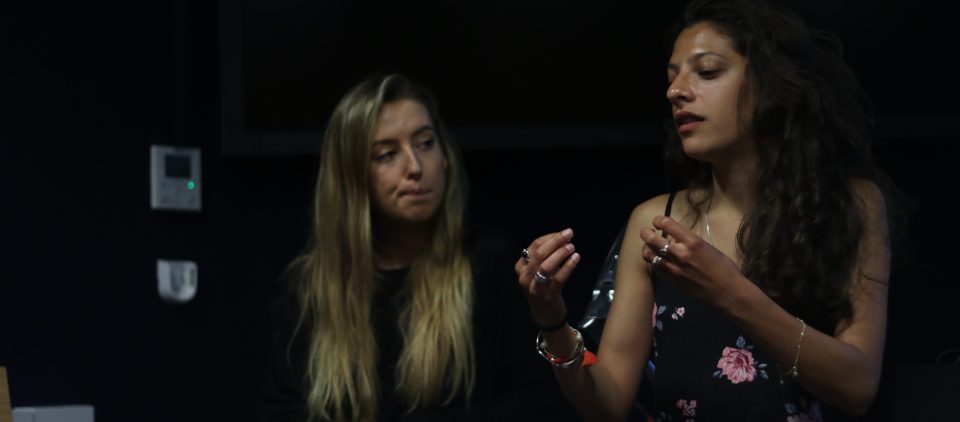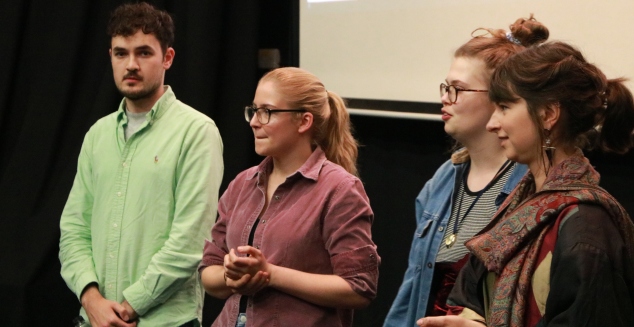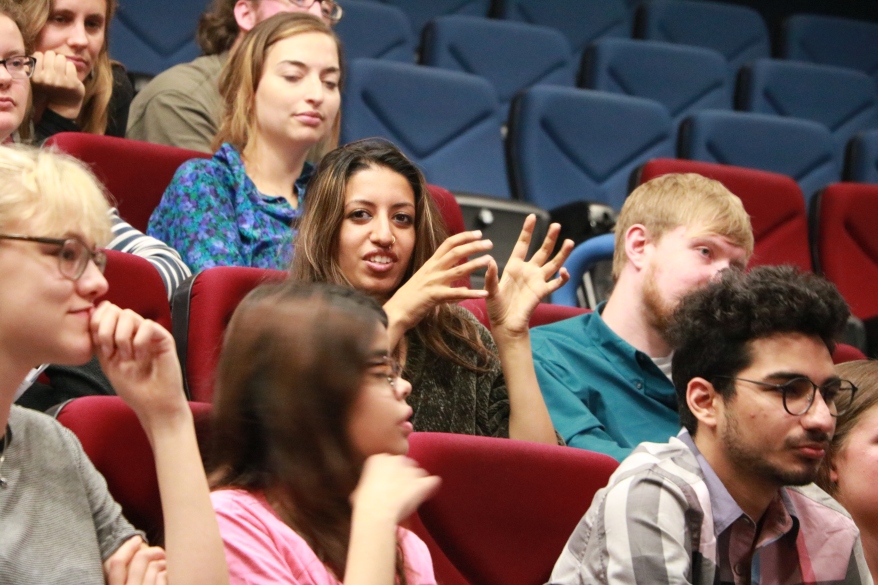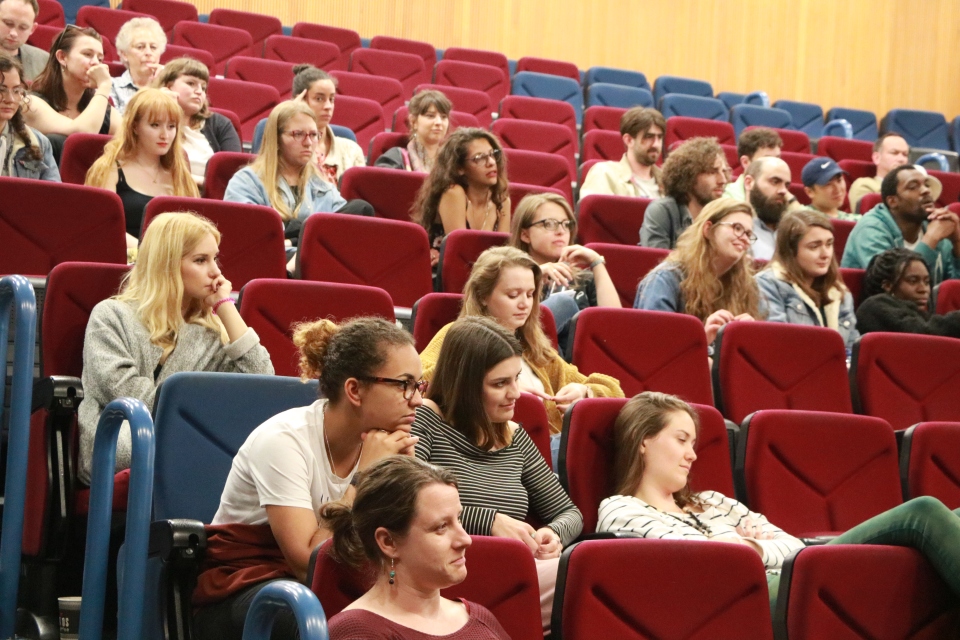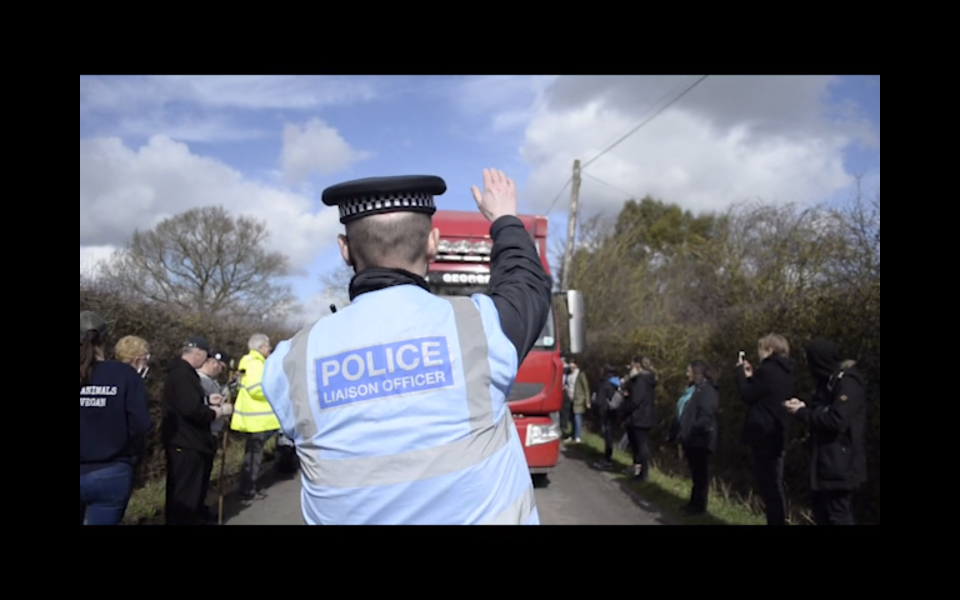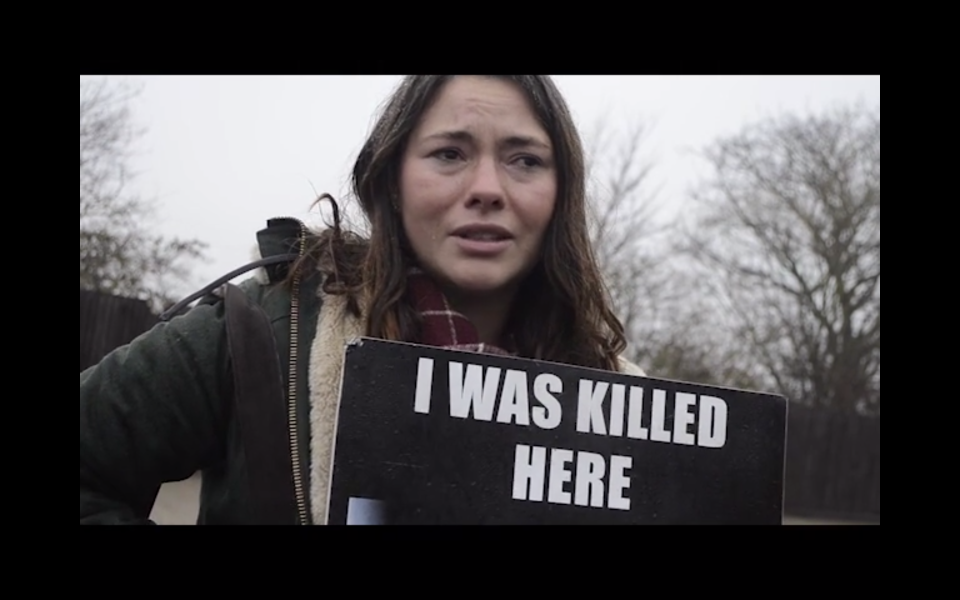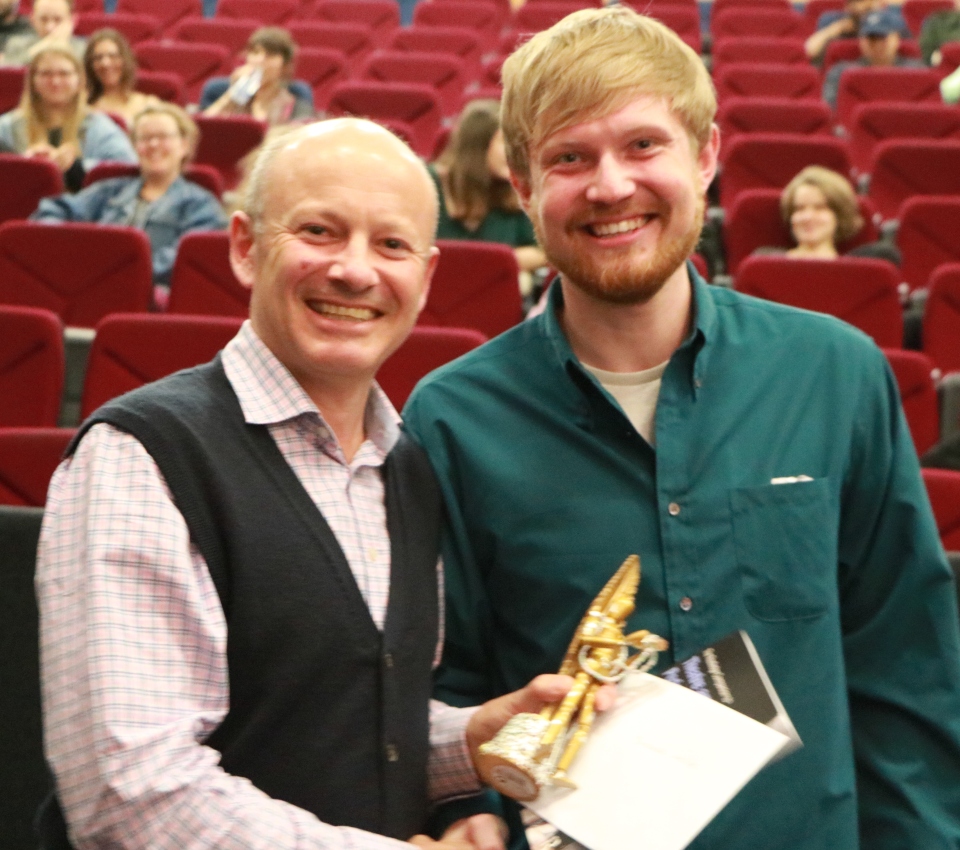Introduction
TRANSPARENCIES 2018 celebrated the creativity and initiative of our students, how they gave of themselves and collaborated to be able to realise the films they wanted. This year we awarded five prizes, each with distinct criteria. Professor Hugh Brody awarded the Hugh Brody Visual Anthropology Prize.
Professor Paul Allain awarded prizes for films that uniquely revealed presence and embodiment. Yasmin Fedda awarded the New Horizons Prize. A Public Engagement Prize in memory of Lynn Bicker and Martin Ripley was awarded by Joe Spence. Visiting Alumni, Charlotte Austwick, Hannah Evans and Alice-Amber Keegan awarded the Alumni Audience Award. You can read more about the prizes and what stood out in the films that were awarded below. The prizes give recognition to exceptional projects, but they also extend the audience and reach of the conversation the films initiate as audio visual gifts. The alumni lunch was an opportunity for current students to hear from alumni what new horizons are open to them. You can view below the video messages from Christiane Howe in Australia, Ruth Krause in Germany and Soffia Kristinsdottir in Costa Rica.
The cultural association of film with entertainment means we are very used to consuming documentaries and then moving onto the next one. While the documentary may seem to be the end result of the process of the filmmaker, for us the viewing can be the start of a journey. All the films screened today have emerged out of unique personal histories and intentions. They are the media manifestations of personal research journeys that gives us cause for conversation and reflection. The symbolic cameras (see below in brochure) was one artistic way that the students communicate this is in a material form. They speak to the issues and concerns addressed in the films while revealing or hinting at the personal intentions of the filmmakers. That is why it is really important to see the films as the start of a conversation, as an audio-visual gift to us and wider audiences, to reflect and learn more about our place in the world and our aspirations for the world we want to live in.
The Q and A after each series of films was an opportunity to start that conversation by exploring how the films spoke to each other. Another opportunity are the interactive websites in which you can learn more about the intentions of the films and how they are located within visual anthropology and social anthropology more broadly. The Public Engagement prize is explicit recognition of the interactive website and its ability to reach out to wider audiences. To view the films and learn more about the projects through the interactive websites click on the links below. We encourage you to make comments on their websites to reciprocate the audio-visual gift.
With thirty one films Transparencies 2018 was the largest screening of visual anthropology projects in the long history of visual anthropology at Kent. It necessitated two parallel screenings in the morning, in the Gulbenkian Cinema and Marlowe Lecture Theatre 2.
1. GULBENKIAN CINEMA
MIGRANT REALITIES
Our first series of films explored the challenges of migration and the current refugee crisis. For Alex Douglas Bailey her Jamaican father is the focus of her exploration. Shalini Arias Hurtado travels to Berlin to try and meet refugees in the Tempelhof refugee centre. Ellie Bush travels to the Calais jungle refugee camp to learn about the life of volunteers. Liam Rowan takes us on a powerfully visual journey, pregnant with repeating motifs, that force reflection on our engagement with migration as we join Liam on a walk to Dover.
Hingland, Alex Douglas Bailey
Multi-faceted Realities, Shalini Arias Hurtado
Wendeing, Liam Rowan
We are Here, Ellie Bush
Images from WENDEING, were used for our poster above.
ART-IDENTITIES
These three films use artistry as their methodology or focus of exploration. Sophie Bell’s focus is her sister’s band and their inspirations. Judith explores sexuality and art practice in a creative and inspirational way. Aadam Khan richly produced soundscapes and pointed interviews encourage us to better feel and understand anxiety.
Off Topic: The Rehearsal, Sophie Bell
Making Identity, Judith Allen
Panic is the Word, Aadam Khan
NATURES
Nature is explored in three very distinct ways in these three moving films. In Forest Alone, Georgious Ntazos, makes us aware of the forest in and around campus and the politics and effects of coppicing. What do the trees think is his underlying question? Liona Jupolli narrates a mystical exploration into her experience of Jungian synchronicity. The future of the planet and climate change is explored through the motivations of Miguel Alexiades’ Anthropocene module, in Liam Hodgetts film.
Forest Alone, Georgios Ntazos
Synchronicity, Liona Jupolli
The Anthropocene Module, Liam Hodgetts
2. MARLOWE SCREENING ROOM, MLT2
SIMULATION
From the mysteries of mapping, via the creation of community in Margate and ghosts in Canterbury to the five rings of combat, these films take us on a journey of simulation in and around Canterbury.
Cartefacts, James Cusens
Creating Communities, Maya Shaw
Boo Canterbury, Kate Pickersgill
The Five Rings, Luke Perry
INBETWEEN
These three films that encourage our appreciation of the inbetween. Andrew Brittain, explores the political situation in his native Ashford, Derya Iyaz, goes on a journey to Whitstable with a local busker and Alice Brucass counterposes two different ideas of masculinity.
A Splash of Red in a Sea of Blue, Andrew Brittain
The Busker, Derya Iyaz
Masc, Alice Brucass
CHANGE
These films demand our attention to their desire for change. Just Listen is Aisha Al-Abdallah’s creative exploration of young women of colour, their voices are powerfully critical and emotive. R. Mohammed asks for an appreciation of what it means to be non-binary. Danielle Fletcher, takes us on her journey of transformation to her new found activism.
Just Listen, Aisha Al-Abdallah
Breaking the Binary, R. Mohammed
Glass Walls, Danielle Fletcher
Symbolic Cameras
ALUMNI LUNCH AND MESSAGES
We were very happy to welcome alumni to the lunch and to screen messages from visual anthropology alumni. Our current students wanted to know where current alumni are and how they got into their current jobs.
Ruth Krause now works at a video journalist, Tv reporter and producer for DW, the German International TV station. She mainly covers environmental topics in Latin America and Africa.
Soffia Kristinsdottir. won the Hugh Brody runner up prize in 2016 for ‘Asocial‘. She sends her message from the Pura Vida Hostel in Costa Rica.
AFTERNOON
GULBENKIAN CINEMA
HAVENS
Being There, Jess Moorhouse
The Nail that Sticks Out, Thomas Hessom
Of Sizzlers and Men, Adriana Cotkova
Boats and Forests, Gabriele Zukauskaite
A local gaming store is the focus of Jess Moorhouse’s loving examination of Canterbury’s haven of gaming. Thomas Hessom meets Japanese young people and journeys with them to understand their idea of home. Cafe des Amis will never be same after you go behind the scenes with Adrian Cotkova’s roving camera. Gabriele Zukauskaite’s focus is home education, we meet those who were home educated, those who home educate and those who intend to.
OUT ON A LIMB

Out on a Limb Q & A. L to R. Sundarii Hernandez Pereyra, Johannes Walter and Ellie Middlemass (For Maddie Spencer)
Go Kambak, Johannes Walter
Surviving, Sundarii Hernandez Pereyra
Jack and I, Madeline Spencer
These films go out on a limb. Johannes Walter travels to the Orkney Islands, to reconnect a Ni Vanuatu woman to her family with photos and video of her family. Surviving is powerfully truthful, ironic, cathartic and inspirational. It confronts us with our assumptions ‘We are all suffering, let’s be honest’. Madeline Spencer tries to understand her brother and mend the relationship in this moving journey to the past. We are left uplifted.
ACTIVE FUTURES
Furusato, Francesca Tesler
Respect Existence or Expect Resistance, Emily Malkin
A Tale of Growing Old, Eleanor Clare Middlemass
Off Grid: A Day in the Life, Milly Wernerus
These four films subtly suggest solutions to the challenges of being active in the future. Furusato focuses on a Zen Buddhist Japanese temple in London. Emily Malkin takes us on a deeply personal journey of activism in three parts, each a different facet of our need to act for change. Ellie MacPherson uses the camera to better know her grandfather, whose ailing eyesight means he will never see the film. Milly Wernerus takes us to a snowy forest to understand the joys and possibilities of living off-grid.
PRIZE GIVING
Current SAC PhD student Joe Spence showed a trailer and gave an update on ‘From the Cubby with Love’ which won the Audience Prize last year in last year’s Caremotions. He then awarded the prize for public engagement in memory of Lynn Bicker and Martin Ripley, one of the subjects of ‘From the Cubby with Love’. This award was funded by Alan Bicker.
Public Engagement Prize
Winner
Jack and I, Madeleine Spencer
Madeline Spencer, in her film “Jack and I”, charts the changing relationship between her and her brother through childhood and up to the present day. This deeply intimate and personal account accentuates the fragilities of family life whilst softly voicing the importance of reunification and forgiveness in the wake of rupture. Spencer’s project is especially courageous given that it not only engages, but attempts to reconcile through film making, painful and potentially unresolved tensions between loved ones. As the credits rolled her audience appeared moved, perhaps guided to reflect on their own lives and family trajectories; emboldened even, to account for lost time and rectify ‘the gap’ (as Spencer puts it) in those relationships. In accompaniment to her film, Spencer offers a well-structured and easily navigable website, populated with a variety of audio/visual materials and engaging reflexive commentaries as to the production process. This is a film for anybody who has known separation in their family, and a hopeful reminder as to the possibility of reconciliation. (Joe Spence)

Ellie MacPherson receives the Prize on behalf of Maddie Spencer. Shalini Arias Hurtado constructed the trophy.
Runner Up
Glass Walls, Danielle Fletcher
Danielle Fletcher, in her film “Glass Walls”, sets out on a mission to an Essex Pig Save event to discover for herself, whether popular media perceptions of animal rights activists are justified. The film maker takes centre stage, declaring her biases at the outset and expressing humility to reconsider her opinions based on her observations. This reflexive approach successfully engages popular audiences, who are encouraged to remain similarly open minded to new ways of thinking. In contrast with many films on the topic of animal rights, which rely on authoritative and grotesque images to force messages across (for example see Earthlings 2005), Fletcher employs powerful subtlety and restraint. Much is left to the audience’s imagination, and it is this clever omission of ‘shock tactics’ which creates room for more productive dialogue across ideological divides. In addition to the film Fletcher offers a website where video diaries draw audiences deeper into the production process, and a directory of activist resources implore continued engagement with the subject. All considered, Fletcher serves up a masterclass in public engagement. (Joe Spence)

Danielle Fletcher receives the Public Engagement runner up prize for her interactive website and film, Glass Walls.
Paul Allain Prize
Winner The Paul Allain Prize
Go Kambak. Johannes Walter
‘This film won because of its capacity to shift time and space as film can do as well as its moving content. Its main focus was on a young mother looking at photos of her extended family, taken by Johannes, now separated by years and 1000s of miles – from Vanuatu to Orkney. Johannes, as filmmaker, was the catalyst that collided these things together. The impact on the film’s protagonist was extraordinary for how she reacted: laughing, crying, swearing, gasping, often all at the same time. The camera just watched, impassive. Her reactions revealed the pain of separation, the joy of discovery, the celebration of memories which coursed through her body and voice as she grabbed at and drunk in the photographs, presented to us witnesses by being overlayed on to the film. Although not technically perfect, it demonstrated the power of the simplicity of allowing a remarkable human story to be told through film.’ (Paul Allain).
Runner up
Synchronicity, Liona Jupolli
‘Liona was brave and bold in all her choices and was so actively engaged both with and in her film. It was creative and risky, sometimes beautiful. It didn’t always work, yet was pushing at what was possible and, as a result, I immediately wanted to see it again, to understand more. Why were she and her group dancing in the streets and underpasses of Barcelona? What did her dance through Canterbury bluebells tell us about her simple one word title, her theme? Her own investment in her work somehow made us seek our own synchronicity with it. Such attempts and creativity are surely to be celebrated.‘ (Paul Allain)
New Horizons Prize
The New Horizons prize was awarded by the award-winning documentary filmmaker Yasmin Fedda, whose films have focused on themes from Edinburgh bakeries to Syrian monasteries. Her films have been BAFTA-nominated and screened at numerous international festivals including Sundance. Her undergraduate background in anthropology and master’s training in visual anthropology at Manchester was inspiring to many students.
Winner: Being There by Jess Moorhouse
Runner up: Breaking the Binary by R. Mohammed
“Breaking The Binary (‘We do not exist!’) was a conversation starter on the existence of gender non-binary people. That is, people who are neither strictly man nor strictly woman, but any combination of between, both, and not. Mostly it was a snapshot of non-binary individuals as real people (wild, right), with a splash of the fact that there does not yet exist any formal legal structures that recognise the status of being not of the binary. The fact that this film cannot be shown without worry is point towards the precarious situation non-binary and other trans people may face. There is, however, increasing material out there on the existence of non-binary people, and it is with my hope that films like these may be shown freely in the future.”
Alumni Audience Award
This award replaced our previous audience prize and acknowledges the importance of our alumni’s engagement and support of our students in making the next step in their journey as visual anthropological filmmakers and researchers.
Charlotte Austwick won the Hugh Brody Runner Up Prize for her film ‘Welcome to the Country’ that was screened in Resolations 2015. She recently worked as a film co-ordinator for the Kenya Quest Expedition, a wildlife conservation and humanitarian aid expedition. Hannah Evans screened her film ‘About Dad’ in Resolations 2015. After graduation she worked in the Campaigns Teams at Restless Development, the youth- led International Development Agency, drawing on her experience volunteering at Amnesty International UK. She left Restless to be a Team Leader with the Youth- Citizenship NGO Pravah, in India, supporting a team of young people in a community engagement programme in Rajasthan. She is now working as Programme Coordinator for Wikimedia UK- focusing on their diversity target to make Wikipedia a more diverse source of open knowledge. Alice-Amber Keegan graduated in 2015 and after teaching English in China for a year is now doing a funded PhD at Durham University on birthing centres and parenting.

Sundarii Hernandez Pereyra receives the Alumni Audience prize from Charlotte Austwick, Hannah Evans and Alice-Amber Keegan.

This old Super 8 camera will be engraved with the winner of the Alumni Audience Award each year. It symbolizes the vital connection to our Alumni network in supporting and inspiring our current students and helping develop the direction of visual anthropology at Kent.

Aadam Khan receives the Alumni Audience runner-up prize from Charlotte Austwick, Alice-Amber Keegan and Hannah Evans.
Hugh Brody Visual Anthropology Prize
In November 2017 Professor Hugh Brody received an honorary doctorate at the University of Kent in recognition of decades of research and work with indigenous peoples. You can view his inspirational speech to graduands at the Graduation Ceremony in Canterbury Cathedral from 6.00.
Professor Jim Groombridge, our Head of School, introduces him at the beginning of the clip.
Unfortunately Professor Hugh Brody was not able to join us in person, but he viewed a selection of films and made comments on them. Dr Rob Fish, our Director of Research, stepped in to share Hugh’s comments and make his own comments of the day. He speaks about how the screening served as an introduction to the department and how the films speak to you in your own experiences.
Gabriele Zukauskaite. – Boats And Forests
‘The narrow boat gliding along a canal is captivating, and the interview that sets up the first part of the film is beautifully shot. I loved the image of the young mother filmed from a low angle, standing up against the sky, the sun and its beams of light behind her head. She stood there tall and strong, with strong and clear words about life and children. I also liked the way tight shots were used – the tying up of the boat, for example, to create a sense of watching closely, of being there. Then the fade out at the end of the boats section and cut to the children and then a wonderful shot of two feet at each side of the frame, and a fallen tree, the forest, holding the centre of the image. And the final line is so great: ‘Don’t have children if you can’t be nice to them. It’s not that hard.’
Adriana Cotkova – Of Sizzlers and Men
‘The restaurant, the place where “an intimate art should be shared in lightly” – that’s a great thought to set up the feel as well as a theme of this film. I was fascinated by the place itself, the work, the energy and enthusiasm. And the images worked brilliantly to take us there and hold us. The camera work is so good, as is the sound quality; and I liked the flow of the edit, the use of such strong material to make it even stronger. I thought that the mix of interview with fly-on-the-wall observation was very skilfully done. Everyone seemed so at ease with the presence of the camera. Classical documentary being done well!There are many powerful images, but I especially liked the shot through the window, with cacti in the foreground and an outside world beyond. Also the window cleaner, at that same window – wonderful! A very compelling and elegantly made film.’
Ellie Bush – We are Here
‘This is a film close to my heart – I spent some time at that warehouse in Calais a couple of years ago, and it was a treat to be taken back there. And a treat to see how this film reminded us that the refugee problem at Calais did not go away just because the authorities there brutally cleared the Jungle camp. The opening of this film is especially strong, I thought, both for its images of posters and the intensity of the sound-track. I found the shot of the two people in the front of the car, driving along and sharing thoughts about wha they are doing to be very compelling. Light problems within the warehouse were obviously quite a challenge, but the interview with the organiser there is still compelling. It was good, and important, to be in Calais, realising that the refugees are sleeping rough, having their tents wrecked or impounded by local police. Many thanks to Ellie Bush for this.‘
Emily Malkin – Respect Existence or Expect Resistance
‘What a great title for a film! And it is a great film – impressive in many ways, but especially because it takes us to a flow of protests. I was particular impressed by the NHS demo sequence, knowing how hard it can be to get voices from within a large and noise event. Each face seemed to be a reason for hope. The cut to the plastic sequence was wonderful, and the sudden appearance of a beautiful beach, and then the image of the bits and pieces of plastic that had been gathered and, as someone says, begins to look like an art work. But the powerful surprise in this film was the shift to the father-daughter relationship, the two of them sitting together, a little self-conscious – not because of the camera, I thought, but because that’s the way it often is between fathers and daughters: the image, the set up, the way the camera was placed, captured something so true and somehow magical. And crucial to understanding the genesis of this film, and of resistance itself. And then the final shot, of the lorry loaded with pigs heading into the abattoir – expressing both failure to save the pigs and a continuing resolve to resist. This is a strong and powerful film.’
Johannes Walter – Go Kambak
‘I loved this back and forth between Vanuatu and some cold northern part of the British Isles. The contrasts of climate, pace, voice. The earlier footage, giving glimpses of Vanuatu and of the people we meet, is fascinating. Even the speeded up and blurred quality – creating a paradox: the place where life moves slowly is rushing along – making a point about memory perhaps; but making me think. I found myself very much liking the film-maker as gentle source of reminders – questions, interest and then photographs. Then the astonishing sequence when Donnelyn is laughing and weeping, all at the same time, in a single complicated burst of feelings, when looking at photos of those she loves who are far far away. I also liked the way some of the stills she is looking at are set into the left side of the frame, so we see the image and her. The final images, carrying the end credits, are unforgettable: using a horizontally split screen to show the two roads, the one in Vanuatu, the other where the family now lives…. Wonderful. Then the last words: ‘I have sent the film back…’Maybe this breaks the rules on length, but it’s a pleasure to watch!’
Francesca Tesler. – Furusato
‘ I very much liked the way this began with a screen split into three, and then resolving into just the one. Then the move into a Buddhist ceremony – we don’t know where we are, or what is going on…. All this shot with elegance. The interview with the Buddhist priest is wonderful – the way he holds a sheet of paper, his notes for what he wants to tell us perhaps, but never looks at them… His quiet dignity. This interview set a tone for the film – this is about something of such deep importance to all who are part of it. And it is a celebration of culture carried by the strength of the images and the quality of the sound. (Though I was sorry that the long prayer did not get translated and subtitled.) As I began to realise that this was culture in exile, the film became more and more compelling. And the wonderful, central thought: cultural practice can be sustained, and given all kinds of new intensity because it is not taking place ‘at home’. So the commitment to what we see is coming from having left where it originated. The shots of the box and the cupboard at then seemed to be full of poignancy. The whole film fascinating and beautifully made.’
Jess Moorhouse – Being There
‘This is perhaps the most surprising of the films I saw: people playing board games….I very much liked the way the film shows us games and the way they are played with very strong and fascinating images and glimpses of all the strange complexity of utterly unfamiliar rules and counters and dice. And I liked the way we went from evening to evening, with a sense that each was special. The camera work to show all this is strong and clear. But for me the power of this film came from something else: as I watched I was suddenly very moved by what it meant for these young men and women to gather together and play games. I felt I was being taken to a powerful if underlying issue of loneliness, and the combating of loneliness. There is a quality to this film that is gentle and respectful – for me, it is these qualities that gave it its strong and surprising intensity of feeling. A fascinating piece of work.’
Milly Wernerus – Off Grid – A day in the life
‘The snow is a character in this film – I loved the way it seemed to be happening in some very remote northern world. Was I being transported to the Canadian subarctic? This made the idea of living off the grid so real and especially compelling. I very much liked the sequences that showed the working of wood. These are beautifully shot, and I thought I could watch forever this remaking of the natural world to meet everyday needs. The splitting of a log into roof shakes is wonderful. I was also very struck by the decision by the film-maker to include herself in shot as a mix of interviewer and conversationalist. And to leave her appreciative laughter on the sound track. Then the final shot, with the film-maker getting up from an interview and walking towards the camera – to switch it off, to end the film. That was a very nice touch.’
Maddie Spencer – Jack and I
‘A snowy day, a young may playing a guitar… The film begins with strong and mood setting images. Then the box of letters. I thought the way we saw and heard bits of a letter was very powerful – drawing me in, giving me a sense of great reality. I found every moment of this film compelling. And it built the story the blend of history ad memory, with great skill. The pieces are put together – Jack’s difficulties, the difficulties these present to the family; the father who is so loving and so absent; the pain of memory and the use of exploration of time to deal with pain; the resolve of the sister to get her brother back. The stills, showing old photos of the father, the family, happy times; and the surprising scenes from some old video footage. These were cut Ito the live-action footage to great effect. I had a sense of being taken right into the lost time. This film seemed to me to be utterly honest, a sharing of a story with us that was very much theirs; and the skillful way the shots and interview materials build the story meant that I was held every moment by being allowed into something so personal. Yet it also resonated – and I am sure that many many families can watch this and see some part of themselves.’
——————
Hugh Brody Runner Up Prize : Jack and I
I choose this for its combination of strong film making skill and remarkable emotional power. It is wonderfully personal but also has large and wide resonances. I think that this is a remarkable achievement – and a tribute to everyone who is shown. The openness and honesty; and the skill with which it is shot and edited. There are many reasons for admiring this film. And one of them is that, for all the difficulties it spells out and owns up to, it delivers a message of hope. The film-maker takes us to lost time to make sure no more time is lost. Thank you for a great piece of work.

The prize was awarded by Dr Rob Fish, Director of Research in the School of Anthropology and Conservation.
Hugh Brody Visual Anthropology Prize: Furusato, Francesca Tesler
This is a beautifully made film that takes us to a culture in exile. It is rich with images and compelling sound. It delivers something special and surprising. The central interviews are straightforward and powerful. The feeling it gives for Buddhism, and for culture in exile, seem to me to be remarkable. There is also great subtlety in the film making. The pacing of interviews, the way the light plays, the mix of shots, and even the wonderful formal garden that so well symbolises the large being retained and caught for its essence in the small. As documentary film must aim to do – so we are reminded that film itself is the Japanese garden. This is a film that gives rise to and allows space for many kinds of thought and appreciation. A great treat to watch. Thank you!
After a long and inspiring day, we all exited to the Gulbenkian bar for drinks and to continue the conversation.



